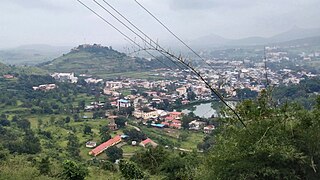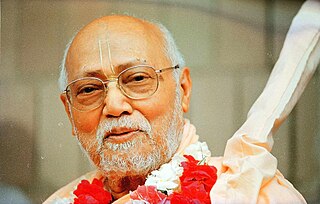Related Research Articles

Raghavendra Tirtha,also referred as Raghavendra Swami,was a Hindu scholar,theologian,and saint. He was also known as Sudha Parimalacharya. His diverse oeuvre include commentaries on the works of Madhva,Jayatirtha,and Vyasatirtha,interpretation of the Principal Upanishads from the standpoint of Dvaita and a treatise on Purva Mimamsa. He served as the pontiff of the matha at Kumbakonam from 1621 to 1671. Raghavendra Tirtha was also an accomplished player of the veena and he composed several songs under the name of Venu Gopala. His shrine at Mantralayam attracts lakhs of visitors every year.
Tirtha is a Sanskrit word that means "crossing place,ford",and refers to any place,text or person that is holy. It particularly refers to pilgrimage sites and holy places in Hinduism,Buddhism and Jainism.

In Jainism,a tīrtha is used to refer both to pilgrimage sites as well as to the four sections of the sangha. A tirtha provides the inspiration to enable one to cross over from worldly engagement to the side of moksha.

Swami Rama Tirtha,also known as Ram Soami,was an Indian teacher of the Hindu philosophy of Vedanta. He was among the first notable teachers of Hinduism to lecture in the United States,travelling there in 1902,preceded by Swami Vivekananda in 1893 and followed by Paramahansa Yogananda in 1920. During his American tours Swami Rama Tirtha spoke frequently on the concept of 'practical Vedanta' and education of Indian youth. He proposed bringing young Indians to American universities and helped establish scholarships for Indian students.

The Skanda Purana is the largest Mukhyapurana,a genre of eighteen Hindu religious texts. The text contains over 81,000 verses,and is of Shaivite literature,titled after Skanda,a son of Shiva and Parvati. While the text is named after Skanda,he does not feature either more or less prominently in this text than in other Shiva-related Puranas. The text has been an important historical record and influence on the Hindu traditions and rituals related to the war-god Skanda.

Sri Jayatirtha,also known asTeekacharya,was a Hindu philosopher,dialectician,polemicist and the sixth pontiff of Madhvacharya Peetha from. He is considered to be one of the most important seers in the history of Dvaita school of thought on account of his sound elucidations of the works of Madhvacharya. He is credited with structuring the philosophical aspects of Dvaita and through his polemical works,elevating it to an equal footing with the contemporary schools of thought. Along with Madhva and Vyasatirtha,he is venerated as one of the three great spiritual sages,or munitraya of Dvaita. Jayatirtha is considered an incarnation of Indra with avesha of Adi Sesha in the Madhva Parampara.

Sripadaraja or Sripadaraya,also known by his pontifical name Lakshminarayana Tirtha,was a Hindu Dvaita philosopher,scholar and composer and the pontiff of the Madhvacharya mutt at Mulbagal. He is widely considered the founder of Haridasa movement along with Narahari Tirtha. He has influenced both Carnatic music and Hindustani music through his compositions. His songs and hymns,written under the mudra of Ranga Vitthala,contain the distillation of Dvaita principles infused with mysticism and humanism. He is also credited with the invention of the suladi musical structure and composed 133 of them along with several kirtanas. He was the advisor of Saluva Narasimha Deva Raya and mentored the young Vyasatirtha. He also authored a commentary on Jayatirtha's Nyaya Sudha called Nyayasudhopanyasa-Vagvajra. Sripadaraja is believed to be the incarnation of Dhruva.

Sri Vadiraja Tirtha was a Dvaita philosopher,poet,traveller and mystic. A polymath of his time,he authored many works,often polemical,on Madhva theology and metaphysics. Additionally,he composed numerous poems and as the pontiff of Sodhe Mutt,renovated the temple complex at Udupi and established the Paryaya system of worship. He is also credited with enriching the Kannada literature of the time by translating Madhvacharya's works to Kannada,giving impetus and contributing to the Haridasa movement. He has influenced both Carnatic and Hindustani music through his compositions. His compositions are mainly in Kannada and Sanskrit. His mudra is 'Hayavadana'. His works are characterised by their poetic flourishes,incisive wit and humour.

Trimbak is a city and a municipal council in Nashik District in the Indian state of Maharashtra. The Trimbakeshwar Shiva Temple is located here,one of the twelve Jyotirlingas,where the Hindu genealogy registers at Trimbakeshwar,Maharashtra are kept. The origin of the sacred Godavari river is near Trimbak.
Prāyaścitta is the Sanskrit word which means "atonement,penance,expiation". In Hinduism,it is a dharma-related term and refers to voluntarily accepting one's errors and misdeeds,confession,repentance,means of penance and expiation to undo or reduce the karmic consequences. It includes atonement for intentional and unintentional misdeeds. The ancient Hindu literature on repentance,expiation and atonement is extensive,with earliest mentions found in the Vedic literature. Illustrative means to repent for intentional and unintentional misdeeds include admitting one's misdeeds,austerities,fasting,pilgrimage and bathing in sacred waters,ascetic lifestyle,yajna,praying,yoga,giving gifts to the poor and needy,and others.

The Uttaradi Math,is one of the main monasteries (matha) founded by Madhvacharya with Padmanabha Tirtha as its head to preserve and propagate Dvaita Vedanta (Tattvavada) outside Tulunadu region. Uttaradi Math is one of the three primary Dvaita monasteries or Mathatraya that descended from Madhvacharya in the lineage of Padmanabha Tirtha through Jayatirtha. After Jayatirtha and Vidyadhiraja Tirtha,Uttaradi Math continued in the lineage of Kavindra Tirtha and later in the lineage of Vidyanidhi Tirtha. The Mūlarāmāand Mūlasītāidols worshipped in the Uttaradi Matha have a long history and are revered among adherents.

Shri Raghavendra Math,better known as Rayara Math is one of the Dvaita Vedanta monasteries (matha) descended from Madhvacharya through Sri Jayatirtha further with Vibudhendra Tirtha. It is one of the three premier monasteries descended in the lineage of Jayatirtha the other two being Uttaradi Math and Vyasaraja Math and are jointly referred as Mathatraya. It is the pontiffs and pandits of the Mathatraya that have been the principle architects of post-Madhva Dvaita Vedanta through the centuries.

Nazrul Tirtha is a cultural and educational center dedicated to the rebel poet Kazi Nazrul Islam. The center is situated in Action Area - I of New Town,Kolkata. It is only 2.50 kilometers away from Rabindra Tirtha. West Bengal Chief Minister Mamata Banerjee inaugurated the center on 24 May 2014 to mark the occasion of the 115th birth anniversary of the poet.

Jambudweep is a Digambara Jain temple in Hastinapur,Uttar Pradesh built by the Jain nunGyanmati in 1972. Jambudweep is a depiction of Jain cosmology Jambudvipa.

Bhakti Ballabh Tirtha was a disciple of Bhakti Dayita Madhava and an acharya and initiating spiritual master in the Gaudiya Math following the philosophy of the Bhakti marg,specifically of Caitanya Mahaprabhu and Gaudiya Vaishnava theology. He was the President Acharya of Sree Chaitanya Gaudiya Math,headquartered at Kolkata,West Bengal,India and having more than 22 branches in India. He was president of the World Vaisnava Association and founder of GOKUL.

Raghuttama Tirtha;IAST:ŚrīRaghūttama Tīrtha),was an Indian philosopher,scholar,theologian and saint. He was also known as Bhavabodhacharya. His diverse oeuvre include commentaries on the works of Madhva and Jayatirtha. He served as the fourteenth pontiff of Madhvacharya Peetha - Uttaradi Math from 1557 to 1595,which he occupied,with remarkable distinction for thirty-nine years. He is considered to be one of the most important seers in the history of Dvaita school of thought. His shrine at Tirukoilur attracts thousands of visitors every year.

Satyanatha Tirtha;IAST:ŚrīSatyanātha Tīrtha),also called Abhinava Vyasaraja,was a Hindu philosopher,scholar,theologian,logician and dialectician belonging to the Dvaita order of Vedanta. He served as the twentieth pontiff of Uttaradi Math from 1660 to 1673. He was a fiery and prolific writer and very ambitious of the glory of Dvaita Vedanta. He is considered to be one of the stalwarts in the history of the Dvaita school of thought,on account of his sound elucidations of the works of Madhvacharya,Jayatirtha and Vyasatirtha. Three of his polemically themed doxographical works are reminiscent of "Vyasatraya". His refutation work Abhinava Gada is a devastating criticism of Appayya's Madhvamathamukhamardhana. His independent treatise Abhinava Chandrika is considered a brilliant work relating to the Brahma Sūtras,being a commentary on Jayatirtha's Tattvaprakashika. His work Abhinava Tarka Tandava refuted the works of rival systems,especially those of Prabhākara of Mimamsa,Ramanuja's Visistadvaita,and Gangesha Upadhyaya,Raghunatha Siromani of the Nyaya school,on the same lines as Vyasatirtha's Tarka Tandava. Indologist B.N.K.Sharma wrote,"His energy and determination to crush out the rivalry of Monism is reflected even in the choice of the titles of some of his works,four of which go by the name "Paraśus" ".

Satyadhyana Tirtha was an Indian Hindu philosopher,scholar,yogi,mystic,theologian and saint. He was the 38th pontiff of Uttaradi Math and served the pontificate from 1911-1942. He was considered most active and zealous pontiffs of 20th century. He was an untiring propagandist,the best debater of his days and almost a terror to his adversaries in philosophical polemics. It was at his initiative and inspiration that a splendid Marathi translation of Madhva's Brahmasutra Bhashya,with the Tatvaprakashika of Jayatirtha was published for the benefit of a large number of followers of Madhvacharya in Maharashtra. He made extensive tours all over India,held disputations and published polemical tracts and phamplets in many languages in North and South India for free distribution. He started,Sriman Madhva Siddhanta Abhivruddhikarini Sabha around 1905-06 and registered in 1930 to promote the study of Sanskrit literature and philosophy,particularly the study of Dvaita Philosophy,to hold meetings and conferences of Madhva scholars.

Satyabodha Tirtha was an Indian philosopher,scholar,yogi,mystic and saint. He was the 25th pontiff of Uttaradi Math and served the pontificate from March 1744 - 9 March 1783. Satyabodha Tirtha was a great yogi and was honoured by both Hindu and Muslim rulers of his time. Satyabodha Tirtha enjoyed a good fame as a miracle-man. Almost all the princes of the South India used to worship him and were his ardent disciples. Murari Rao of Gooty,Raghoji Bhosale and Fateh Singh Rao Gaekwad,were his great disciples. Satyabodha Tirtha Swamiji's mission of peace has played a prominent role during this time. He earned a reputation as the greatest of Madhva saints of his time for his un-rivaled scholarship,miraculous achievements and dynamism as the pontiff of the Uttaradi Math. So many were his achievements and so well was he liked,admired and respected by people of all castes and creeds,rich and poor,that the Uttaradi Math in Savanur got the name as Satyabodha Math after him. Satyabodha Tirtha is believed to be the incarnation of Markandeya.
References
- ↑ "Know Your NC Candidate: Samtse".
- ↑ "Hon. Tirtha Man Rai". www.nationalcouncil.bt.